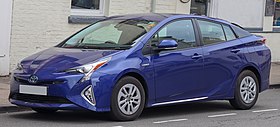
Back مركبة كهربائية هجينة Arabic Vehicle elèctric híbrid Catalan Cerbyd trydan heibrid Welsh Hybridelektrokraftfahrzeug German Vehículo híbrido eléctrico Spanish Ibilgailu elektriko hibrido Basque خودروی برقی دوگانه Persian Automobile hybride électrique French הנעה היברידית HE Hibridno električno vozilo Croatian


A hybrid electric vehicle (HEV) is a type of hybrid vehicle that couples a conventional internal combustion engine (ICE) with one or more electric engines into a combined propulsion system. The presence of the electric powertrain, which has inherently better energy conversion efficiency, is intended to achieve either better fuel economy or better acceleration performance than a conventional vehicle. There is a variety of HEV types and the degree to which each functions as an electric vehicle (EV) also varies. The most common form of HEV is hybrid electric passenger cars, although hybrid electric trucks (pickups, tow trucks[2] and tractors), buses, motorboats,[3] and aircraft also exist.
Modern HEVs use energy recovery technologies such as motor–generator and regenerative braking to recycle the vehicle's kinetic energy to electric energy via an alternator, which is stored in a battery pack or a supercapacitor. Some varieties of HEV use an internal combustion engine to directly drive an electrical generator, which either recharges the vehicle's batteries or directly powers the electric traction motors; this combination is known as a range extender.[4] Many HEVs reduce idle emissions by temporarily shutting down the combustion engine at idle (such as when waiting at the traffic light) and restarting it when needed; this is known as a start-stop system. A hybrid-electric system produces less tailpipe emissions than a comparably sized gasoline engine vehicle since the hybrid's gasoline engine usually has smaller displacement and thus lower fuel consumption than that of a conventional gasoline-powered vehicle. If the engine is not used to drive the car directly, it can be geared to run at maximum efficiency, further improving fuel economy.
Ferdinand Porsche developed the Lohner–Porsche in 1901.[3] But hybrid electric vehicles did not become widely available until the release of the Toyota Prius in Japan in 1997, followed by the Honda Insight in 1999.[5] Initially, hybrid seemed unnecessary due to the low cost of gasoline. Worldwide increases in the price of petroleum caused many automakers to release hybrids in the late 2000s; they are now perceived as a core segment of the automotive market of the future.[6][7][better source needed]
As of April 2020[update], over 17 million hybrid electric vehicles have been sold worldwide since their inception in 1997.[8][9] Japan has the world's largest hybrid electric vehicle fleet with 7.5 million hybrids registered as of March 2018[update].[10] Japan also has the world's highest hybrid market penetration with hybrids representing 19.0% of all passenger cars on the road as of March 2018[update], both figures excluding kei cars.[10][11] As of December 2020[update], the U.S. ranked second with cumulative sales of 5.8 million units since 1999,[12] and, as of July 2020[update], Europe listed third with 3.0 million cars delivered since 2000.[13]
Global sales are led by the Toyota Motor Corporation with more than 15 million Lexus and Toyota hybrids sold as of January 2020[update],[8] followed by Honda Motor Co., Ltd. with cumulative global sales of more than 1.35 million hybrids as of June 2014[update];[14][15][16] As of September 2022[update], worldwide hybrid sales are led by the Toyota Prius liftback, with cumulative sales of 5 million units.[1] The Prius nameplate had sold more than 6 million hybrids up to January 2017.[17] Global Lexus hybrid sales achieved the 1 million unit milestone in March 2016.[18] As of January 2017[update], the conventional Prius is the all-time best-selling hybrid car in both Japan and the U.S., with sales of over 1.8 million in Japan and 1.75 million in the U.S.[17][9]
- ^ a b "World Premiere of All-New Prius in Japan" (Press release). Toyota Global. 2022-02-22. Retrieved 2022-02-22.
- ^ Yakub, Mehanaz (2024-09-25). "Lion Electric, CAA-Quebec deploy North America's first e-tow truck". Electric Autonomy Canada. Retrieved 2024-10-17.
- ^ a b "History of Hybrid Vehicles". HybridCars.com. 2006-03-27. Archived from the original on 2009-02-08. Retrieved 2010-03-21.
- ^ "Alternative Fuels Data Center: How do Hybrid Electric Cars Work?".
- ^ Matt Lake (2001-11-08). "How it works; A Tale of 2 Engines: How Hybrid Cars Tame Emissions". The New York Times. Retrieved 2010-03-22.
- ^ Elizabeth Lowery (2007-07-01). "Energy diversity as a business imperative". The Futurist. Retrieved 2010-03-21.
- ^ Dale Buss and Michelle Krebs (2008-06-03). "Big Three, Big Vehicles Taken to the Watershed in May". Edmunds Auto Observer. Archived from the original on 2011-07-07. Retrieved 2010-03-21.
- ^ a b Cite error: The named reference
TMC15miHEVswas invoked but never defined (see the help page). - ^ a b Cite error: The named reference
US4miwas invoked but never defined (see the help page). - ^ a b Cite error: The named reference
Jap7miwas invoked but never defined (see the help page). - ^ Cite error: The named reference
JapanHEVcapitalwas invoked but never defined (see the help page). - ^ Stacy C. Davis; Robert G. Boundy (April 2021). "Transportation Energy Data Book: Edition 39 (updated April 2021)" (PDF). Oak Ridge National Laboratory, Office of Energy Efficiency and Renewable Energy, U.S. Department of Energy. Retrieved 2021-05-16. See Table 6.2: Hybrid and Plug-In Vehicle Sales, 1999-2020
- ^ Cite error: The named reference
TMC3miHEVswas invoked but never defined (see the help page). - ^ Honda Press Release (2012-10-15). "Cumulative worldwide sales of Honda hybrids passes 1 million units". Green Car Congress. Retrieved 2012-10-16.
- ^ Cite error: The named reference
Honda2013was invoked but never defined (see the help page). - ^ Cite error: The named reference
Honda062014was invoked but never defined (see the help page). - ^ a b Cite error: The named reference
TMC10miHEVswas invoked but never defined (see the help page). - ^ Cite error: The named reference
Lexus1miwas invoked but never defined (see the help page).